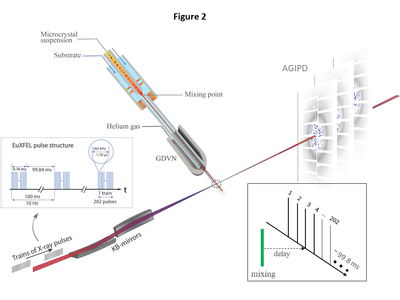Journal:IUCrJ:S2052252521008125
From Proteopedia
(Difference between revisions)

| Line 10: | Line 10: | ||
rate, the delay is fixed by the distance of the mixing region from the X-ray interaction region. All pulses in all trains (here pulse #3) probe the same time delay. The EuXFEL pulse structure is most efficiently used.]] | rate, the delay is fixed by the distance of the mixing region from the X-ray interaction region. All pulses in all trains (here pulse #3) probe the same time delay. The EuXFEL pulse structure is most efficiently used.]] | ||
{{Clear}} | {{Clear}} | ||
| - | <scene name='88/889829/Cv/ | + | <scene name='88/889829/Cv/4'>Test2</scene> |
We follow the increase of the CEF occupancy in the catalytic cleft of BlaC from 5 ms to 50 ms after mixing with CEF by XFEL based MISC experiments. From the increasing occupancy values we are able to estimate an effective diffusion coefficient Deff of CEF in the BlaC microcrystals. Diffusion is roughly an order of magnitude slower in the crystals than that in water. By using the Deff we are now able to calculate CEF occupancies anywhere in the microcrystals and at any time. Since the BlaC-CEF complex formation triggers the enzymatic cycle, the speed of its formation determines the time-resolution of the MISC method. Our results show that the time-resolution is on the order of 5 ms for our microcrystals. The structures of any intermediates whose lifetimes are longer can therefore be characterized. Once faster intermediates are concerned, smaller crystals must be used that support a faster buildup of the enzyme substrate complex. | We follow the increase of the CEF occupancy in the catalytic cleft of BlaC from 5 ms to 50 ms after mixing with CEF by XFEL based MISC experiments. From the increasing occupancy values we are able to estimate an effective diffusion coefficient Deff of CEF in the BlaC microcrystals. Diffusion is roughly an order of magnitude slower in the crystals than that in water. By using the Deff we are now able to calculate CEF occupancies anywhere in the microcrystals and at any time. Since the BlaC-CEF complex formation triggers the enzymatic cycle, the speed of its formation determines the time-resolution of the MISC method. Our results show that the time-resolution is on the order of 5 ms for our microcrystals. The structures of any intermediates whose lifetimes are longer can therefore be characterized. Once faster intermediates are concerned, smaller crystals must be used that support a faster buildup of the enzyme substrate complex. | ||
Revision as of 11:54, 9 August 2021
| |||||||||||
This page complements a publication in scientific journals and is one of the Proteopedia's Interactive 3D Complement pages. For aditional details please see I3DC.

